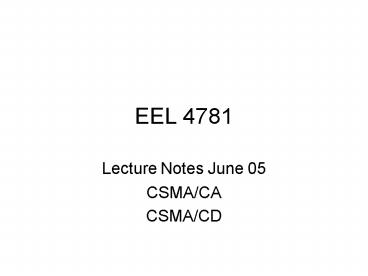EEL 4781 PowerPoint PPT Presentation
1 / 21
Title: EEL 4781
1
EEL 4781
- Lecture Notes June 05
- CSMA/CA
- CSMA/CD
2
Wireless Networks Taxonomy
LAN
MAN
Wireless Networks
WAN
PAN
3
WLAN Architecture
- Infrastructure-less (Ad hoc)
- Nodes communicate with each other without base
station (BS). - Infrastructure based
- Nodes communicate with an access point (AP).
- Set of computers within range of a given AP form
a Basic Service Set (BSS)
4
Ad hoc Network
4
5
Infrastructure Based
BSS 2
BSS 1
5
6
802.11 Channel Access
- Contention-free Point Coordination Function
(PCF) - AP controls the stations in the BSS
- AP uses, e.g., FDM to assigns different
frequencies to the stations in the BSS - Not used in practice
- Contention-based Distributed Coordination
Function (DCF) - Each station in the DCF runs a random access
protocol i.e. CSMA/CA
7
Carrier Sense Multiple Access with Collision
Avoidance (CSMA/CA)
- DIFS distributed inter-frame space
- If medium is free, wait for DIFS
- CW Contention window
- After DIFS, backoff for a random number in the CW
before sending the initial packet. - SIFS short inter-frame space
- This is the time the AP waits before sending
reply - DIFS SIFS (2 Slot Time)
- Collision is detected if no ACK is received
8
Node A sends to Access Point B
rA 4
- CW Contention Window. Starts only after DIFS.
- Random number r picked form range CWmin to
CWmax - r can be decremented only in CW
- CW grows with every collision as follows
- CWRANGE 0 , 2 2i 1 ,
i is the transmission attempt - So, initially, CW 0 7, after 1st
collision, CW 0 15, etc.
8
9
A and C send to Access Point B
Case No collision
rA becomes 0
rA4
DIFS
DATAA
ACKB
DATAC
A
DIFS
SIFS
rc becomes 0
rc6
freeze
DATAC
C
DIFS
DIFS
- What if rA and rC had both been picked as 4 ?
- What if rA and rC has collided and DATAA length
was 10 while - DATAC length were 15 ?
802.11
9
10
A and C send to Access Point B
Case Collision
DATAC
rA4, rc4
rA4, rc6
DATAA
DIFS
SIFS
DIFS
- Length (DATAA) 10 Slot times
- Length (DATAC) 15 Slot times
A and C time out
802.11
10
11
NAV Network Allocation Vector
NAV is an indicator of time periods when the node
will not initiate a new transmission
rA2
DIFS
STAA
DATA
SIFS
ACK
STAB
NAVB
STAC
DIFS
DIFS
rc3
NAVC
11
12
The Hidden Node Problem
STAC
STAB
STAA
12
13
Solution for the Hidden Node Problem
- RTS/CTS
- RTS (Request To Send) - (Approx 20 bytes)
- CTS (Clear To Send) - (Approx 16 bytes)
- Use of RTS/CTS is optional
- Solves two problems
- Hidden Node Problem
- Wastage of time due to collisions
- Maximum MSDU is 2304 bytes
13
14
Preventing Collision
Step 1 A sends RTS to B Step 2 B broadcasts
CTS Ste 3 C and D receive Bs CTS and know that
the A is going to be transmitting
RTS
CTS
C
B
A
CTS
CTS
D
14
15
Preventing Collision
RTS and CTS have packet duration information. C
and D use the CTS to set their NAV. B can set its
NAV upon receiving RTS.
RTS
CTS
C
B
A
CTS
CTS
D
15
16
DIFS
SIFS
SIFS
SIFS
DIFS
CW
STAA
RTS
DATA
STAB
CTS
ACK
NAV
DIFS
NAV
STAC
DIFS
STAD
NAV
DIFS
16
17
Ethernet (802.3)
- CSMA/CD
18
CSMA/CD in 802.3
- If a node A has data to send, it first senses the
medium. - If medium is idle, A transmits its frame.
- If medium is busy, A defers transmission until
medium is free, then transmits. - A collision occurs if two frames sense medium as
idle at the same time and send their data at the
same time.
19
Collision recovery
- After collision, each colliding node employs a
Binary Exponential Backoff (BEB). - The contention window grows as follows
- CW 0 , 2i - 1, i is the collision number.
- So, after the 1st collision, CW 0 , 1
- After the 2nd collision, CW 0 , 4
- After the 3rd collision, CW 0 , 7
- Note that contrary to 802.3, 802.11 employs
backoff for every transmission.
20
A and B have data to send
Case No collision
At this time, A has data to send
DATAA
A
IFG
defer
DATAB
B
IFG
At this time, B has data to send
20
21
A, B send data at the same time
Case Collision
rA0
DATAA
DATAA
A
IFG
rB1
defer
DATAB
DATAB
B
IFG
rB becomes 0
- IFG Inter-frame gap
- DataA 5 Slot times, DataB 5 Slot times
21

